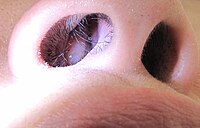
Photo from wikipedia
INTRODUCTION Chronic rhinosinusitis (CRS) is a heterogeneous disease with a variety of cellular and molecular pathophysiologic mechanisms. Biomarkers have been explored in CRS using various phenotypes, such as polyp recurrence… Click to show full abstract
INTRODUCTION Chronic rhinosinusitis (CRS) is a heterogeneous disease with a variety of cellular and molecular pathophysiologic mechanisms. Biomarkers have been explored in CRS using various phenotypes, such as polyp recurrence after surgery. Recently, the presence of regiotype in CRS with nasal polyps (CRSwNP) and the introduction of biologics for the treatment of CRSwNP has indicated the importance of endotypes, and there is a need to elucidate endotype-based biomarkers. AREAS COVERED Biomarkers for eosinophilic CRS, nasal polyps, disease severity, and polyp recurrence have been identified. Additionally, endotypes are being identified for CRSwNP and CRS without nasal polyps using cluster analysis, an unsupervised learning technique. EXPERT OPINION Endotypes in CRS have still being established, and biomarkers capable of identifying endotypes of CRS are not yet clear. When identifying endotype-based biomarkers, it is necessary to first identify endotypes clarified by cluster analysis for outcomes. With the application of machine learning, the idea of predicting outcomes using a combination of multiple integrated biomarkers, rather than a single biomarker, will become mainstream.
Journal Title: Expert review of clinical immunology
Year Published: 2023
Link to full text (if available)
Share on Social Media: Sign Up to like & get
recommendations!